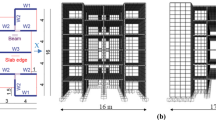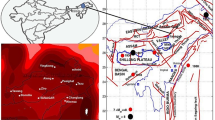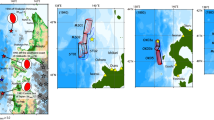Abstract
Earthquake engineering parameters are very important in the engineering field, especially engineering anti-seismic design and earthquake disaster prevention. In this study, we focus on simulating earthquake engineering parameters by the empirical Green’s function method. The simulated earthquake (MJMA6.5) occurred in Kyushu, Japan, 1997. Horizontal ground motion is separated as fault parallel and fault normal, in order to assess characteristics of two new direction components. Broadband frequency range of ground motion simulation is from 0.1 to 20 Hz. Through comparing observed parameters and synthetic parameters, we analyzed distribution characteristics of earthquake engineering parameters. From the comparison, the simulated waveform has high similarity with the observed waveform. We found the following. (1) Near-field PGA attenuates radically all around with strip radiation patterns in fault parallel while radiation patterns of fault normal is circular; PGV has a good similarity between observed record and synthetic record, but has different distribution characteristic in different components. (2) Rupture direction and terrain have a large influence on 90 % significant duration. (3) Arias Intensity is attenuating with increasing epicenter distance. Observed values have a high similarity with synthetic values. (4) Predominant period is very different in the part of Kyushu in fault normal. It is affected greatly by site conditions. (5) Most parameters have good reference values where the hypo-central is less than 35 km. (6) The GOF values of all these parameters are generally higher than 45 which means a good result according to Olsen’s classification criterion. Not all parameters can fit well. Given these synthetic ground motion parameters, seismic hazard analysis can be performed and earthquake disaster analysis can be conducted in future urban planning.













Similar content being viewed by others
References
Aki K (1967) Scaling law of seismic spectrum. J Geophys Res 72(4):1217–1231
Aki K, Richards PG (1980) Quantitative Seismology: Theory and Methods. Freeman, San Francisco
Arias A (1970a) Measure of earthquake intensity. Massachusetts Inst. of Tech., Cambridge Univ. of Chile, Santiago de Chile
Arias A (1970b) Measure of earthquake intensity. Seismic design for nuclear power plants. The M.I.T.Press, Cambridge, MA, pp. 438–483
Beresnev IA, Atkinson GM (1999) Generic finite-fault model for ground-motion prediction in eastern North America. Bull Seismol Soc Am 89(3):608–625
Bolt BA (1973) Duration of strong ground motion. Proc. 5th World Conf. Earthquake. Eng., Rome
Bommer JJ, Magenes G, Hancock J, Penazzo P (2004) The influence of strong motion duration on the seismic response of masonry structures. Bull Earthq Eng 2(1):1–26
Boore DM (1983) Stochastic simulation of high-frequency ground motions based on seismological models of the radiated spectra. Bull Seismol Soc Am 73(6 A):1865–1894
Boore DM (2003) Simulation of ground motion using the stochastic method. Pure Appl Geophys 160(3–4):635–676
Bouchon M (1979) Discrete wave number representation of elastic wave fields in three-space dimensions. Journal of Geophysical Research: Solid Earth 84(B7):3609–3614
Bray JD, Rathje EM (1998) Earthquake-induced displacements of Solid-waste Landfills. J Geo-tech Geo-environ Eng ASCE 124(3):242–253
Brune JN (1970) Tectonic stress and the spectra of seismic shear waves from earthquakes. J Geophys Res 75(26):4997–5009
Dangmin C, Rui D (2013) Amplification effects of site conditions on ground peak accelerations. Journal of earthquake engineering and engineering vibration 33:1
Del Gaudio V, Wasowski J (2004) Time probabilistic evaluation of seismically induced landslide hazard in Irpinia (southern Italy). Soil Dyn Earthq Eng 24(12):915–928
Dobry R, Idriss IM, Ng E (1978) Duration characteristics of horizontal components of strong-motion earthquake records. Bull Seismol Soc Am 68(5):1478–1520
Eringen A, Suhubi E (1975) Elastodynamics, vol 2, Line Theory. Academic Press, Inc, New York
Gallovič F, Brokešová J (2007) Hybrid k-squared source model for strong ground motion simulations: introduction. Phys Earth Planet Inter 160(1):34–50
GB18306 (2015) Seismic ground motion parameters zonation map of China
Hanks TC, Kanamori HA (1979) moment magnitude scale. J Geophys Res B 84(B5):2348–2350
Hanks T, McGuire R (1981) The character of high frequency strong ground motion. Bull Seismol Soc Am 71:2071–2095
Hartzell SH (1978) Earthquake aftershocks as Green’s functions. Geophys Res Lett 5(1):1–4
Helmberger DV (1968) The crust-mantle transition in the Bering Sea. Bull Seismol Soc Am 58(1):179–214
Horikawa H (2001) Earthquake doublet in Kagoshima, Japan: rupture of asperities in a stress shadow. Bull Seismol Soc Am 91(1):112–127
InrruRe K. (1983) Semi-empirical estimation of strong ground motions during large earthquakes
Irikura K (1986) Prediction of strong acceleration motion using empirical Green’s function. Proc 7th Japan Earthquake Engineering Symposium:151–156
Irikura K, Kagawa T, Sekiguchi H (1997) Revision of the empirical green’s function method by Irikura (1986) (program and abstract). J Seismol Soc Japan 2:B25 (in Japanese)
Irikura K, Kamae K (1994) Estimation of strong ground motion in broad-frequency band based on a seismic source scaling model and an empirical Green’s function technique. Ann Geophys 37(6)
Irikura K, Miyake H (2011) Recipe for predicting strong ground motion from crustal earthquake scenarios. Pure Appl Geophys 168(1–2):85–104
Junju X (2010) in Chinese Characteristics of near-fault strong motion from Ms8.0 WenChuan earthquake. Beijing, Institute of geophysics, china earthquake administration
Kanamori H, Anderson DL (1975) Theoretical basis of some empirical relations in seismology. BSSA 65(5):1073–1095
Kayen RE, Mitchell JK (1997) Assessment of liquefaction potential during earthquakes by Arias intensity. J Geotech Geoenviron 123(12):1162–1174
Kempton JJ, Stewart JP (2006) Prediction equations for significant duration of earthquake ground motions considering site and near-source effects. Earthq Spectra 22(4):985–1013
Keiiti A (1968) Seismic displacements near a fault
Miyake H, Iwata T, Irikura K (2001) Estimation of rupture propagation direction and strong motion generation area from azimuth and distance dependence of source amplitude spectra. Geophys Res Lett 28(14):2727–2730
Miyake H, Iwata T, Irikura K (2003) SourceCharacterization for broadband ground-motion simulation: kinematic heterogeneous source model and strong motion generation area. Bull Seismol Soc Am 93(6):2531–2545
Olsen KB, Mayhew JE (2010) Goodness-of-fit criteria for broadband synthetic seismograms, with application to the 2008 Mw 5.4 Chino Hills, California, Earthquake. Seismol Res Lett 81(5):715–723
Seed HB, Lee KL (1966) Liquefaction of saturated sands during cyclic loading. J Soil Mech Found Div 92:105–134
Somerville P, Irikura K, Graves R, et al. (1999) Characterizing crustal earthquake slip models for the prediction of strong ground motion. Seismol Res Lett 70(1):59–80
Travasarou T, Bray JD, Abrahamson NA (2003) Empirical attenuation relationship for Arias Intensity. Earthq Eng Struct Dyn 32(7):1133–1155
Trifunac MD, Brady AG (1975) A study on duration of strong earthquake ground motion. Bull Seismol Soc Am 65(3):581–626
Wald DJ, Quitoriano V, Heaton TH, et al. (1999) Relationships between peak ground acceleration, peak ground velocity, and modified Mercalli intensity in California. Earthquake Spectra 15(3):557–564
Wang XY, Nie GZ, Zhang L (2010) Relationship between landslides induced by the Wenchuan earthquake and Arias Intensity. Journal of Basic Science and Engineer 18(4):645–656
Yuxian H (2006) Earthquake engineering, 2nd edn. Seismological Press, Beijing
Acknowledgments
This research work was supported by China Earthquake Science Array Detection (023003), the National Natural Science Foundation (51278470), the National Science Technology Support Plan Projects (2012BAK15B01-05), and the Seismic Safety Evaluation Classification-Key Technology Index Determination-National Standard Revision Research (024004). The earthquake records come from K-NET of Japan (http://www.kyoshin.bosai.go.jp/kyoshin/data).
Author information
Authors and Affiliations
Corresponding author
Rights and permissions
About this article
Cite this article
Li, Z., Chen, X., Gao, M. et al. Simulating and analyzing engineering parameters of Kyushu Earthquake, Japan, 1997, by empirical Green function method. J Seismol 21, 367–384 (2017). https://doi.org/10.1007/s10950-016-9606-4
Received:
Accepted:
Published:
Issue Date:
DOI: https://doi.org/10.1007/s10950-016-9606-4




